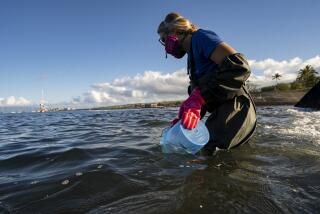Invasive species from Japan ride tsunami debris to American shores
Millions of hitchhikers are being carried to American coasts on large pieces of debris set adrift by last year’s Japanese tsunami. Now scientists are concerned that these invading organisms — both plants and animals — could disrupt marine ecosystems in their new homes.
Over 5 million tons of debris washed out to sea after the tsunami caused by the massive 9.0 earthquake that struck Japan in March 2011. An estimated 1.5 million tons of that debris has traveled across the Pacific Ocean to the stretch of North American coastline between Alaska and Southern California. Some of the biggest pieces of garbage — docks, ships and parts of houses, buildings or cars — have been discovered with shellfish, algae, plankton and barnacles on board.
Patrick Krug, a marine biologist at Cal State Los Angeles, talked with The Times about the potential risks posed by invasive species from Japan.
How have invasive species been a problem in the past?
What we have unfortunately done as human beings is come up with ways to accidentally move species around. So there are hundreds of invasive species in California that have come from Asia that have been introduced accidentally in a variety of ways. The most common are small adults that get introduced when we import oysters form Japan to farm here. The other way is they hitchhike on boats.
The tsunami is a new way for species to get around. We now suddenly face a situation where dozens of these species have started to spread and colonize our coast. It is unusual to have a simultaneous invasion by a huge number of species.
What are some examples of debris that carried species across the ocean from Japan?
Most of the information that is out there pertains to things that have washed up in Oregon. A 65-foot floating dock from Japan that sat in the ocean for many years accumulated a community of organisms — algae, mussels and clams.
The tsunami ripped this massive dock off and it got carried by ocean currents for 15 months, bringing the community with it. Researchers from Oregon State University identified several species [attached to the dock] that have not yet invaded our coast but that have invaded other parts of the world — species that you don’t want to get a foothold because you can never get rid of them. For example, a starfish native to Japan has invaded Australia and eats clams and scallops.
The dock was the biggest piece of debris that had already been in the water, but there are 1.5 million tons of debris in the ocean. How much of it will land on our shore is uncertain and most of it is stuff that didn’t already have marine organisms growing on them. Its possible that as it floated around in the ocean off the coast of Japan, the debris could have been colonized.
Does California have a record of being vulnerable to invasive species?
Yes. San Francisco Bay is probably the most invaded place on our coast — invading species there have almost completely displaced native species. There are almost 164 invasive species in San Francisco alone. Many of those species have spread both north and south, and many have been independently introduced to Southern California. The ports of Los Angeles and Long Beach are shipping hubs where the species commonly invade.
How can this problem of tsunami-fueled invasive species be solved?
The efforts are being coordinated by NOAA, the National Oceanic and Atmospheric Administration. But principal responsibility is going to fall on the states.
Researchers, local agencies and volunteers have teamed up, but to my knowledge there is no plan in place. At the moment we are reacting to things as they land, but don’t have a plan for moving forward.
Return to the Science Now blog.






